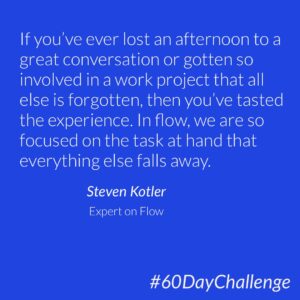 You’ve probably experienced flow at some point––the state of mind where you are completely immersed in an activity, losing sight of anything outside of your work. Learning intensely.
You’ve probably experienced flow at some point––the state of mind where you are completely immersed in an activity, losing sight of anything outside of your work. Learning intensely.
In The Rise of Superman: Decoding the Science of Ultimate Human Performance, author Steven Kotler writes,
If you’ve ever lost an afternoon to a great conversation or gotten so involved in a work project that all else is forgotten, then you’ve tasted the experience. In flow, we are so focused on the task at hand that everything else falls away. (pg. viii)
How often do educators (teachers and leaders) experience flow as described by Kotler?
How about learners inside schools and classrooms? Outside schools and classrooms?
The dominant paradigm of learning––the school-centered paradigm––is focused on dissemination of content knowledge and the filling of learners like vessels. In the school-centered paradigm, flow is not a high priority.
In addition to a lack of flow experiences, time is filled with noise––tasks such as standardized testing, collecting enough points for a good grade, creation of efficient schedules and keeping the school in compliance with state and federal regulations. Tasks that are opposed to the known triggers of flow.
On the other hand, in human-centered models (such as Montessori) where there is focus on real-world problem-identification, designing systems to support the solving of those problems, and the elevation of learner agency and relationships between young and older learners alike, flow is a necessary and critical condition for deep and powerful learning.
These environments are characterized by focus, not noise.
So how do we create the conditions of flow…for ourselves and for our learners? In Kottler’s latest book, The Art of the Impossible, he shares 21 flow triggers discovered as part of his research at the Flow Genome Project.
The 21 triggers are presented in four categories:
Internal Triggers: autonomy, curiosity-passion-purpose, complete concentration, clear goals, immediate feedback, the challenge-skills balance
External Triggers: high consequences, rich environment, deep embodiment
Creative Triggers: risk taking, pattern recognition
Social Triggers: complete concentration; shared, clear goals; shared risk; close listening; good communication; blending egos; equal participation; familiarity; sense of control, always say yes
Some of these may be challenging to understand just by the names. You’ll have to read Chapter 21 in the book to get the details or watch the video linked below.
But the big takeaway is this: These triggers are your toolbox. If you want more flow in your life, then build your life around these triggers. (pg. 234)
—–
❓ Provocations:
In what ways are we supporting flow in the lives of the young learners and the adults in the system? In what ways do structural components of a school-centered system detract from the necessary flow? How would we redesign learning for optimal flow? Why is this even important?
💎 Resources:
How to get into the flow state (video) – Steven Kotler
🧠 Mindset:
Flow
💡 Area:
Learning; Leadership
📣 Drop your thoughts in the comments, or in the Facebook group, and feel free to share resources. 🔥🔥🔥
- A silver lining - January 22, 2022
- Is our use of tech working against us? 🤔 - September 8, 2021
- What’s NOT going to change in the next 10 years? 🤔 - September 7, 2021